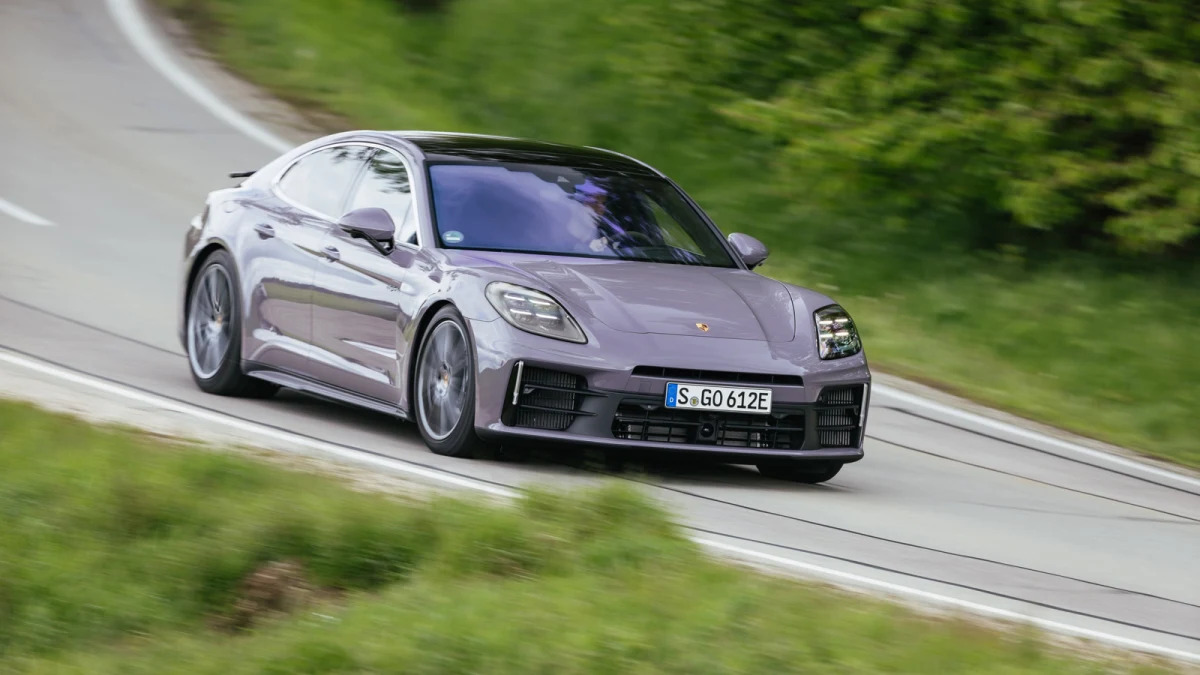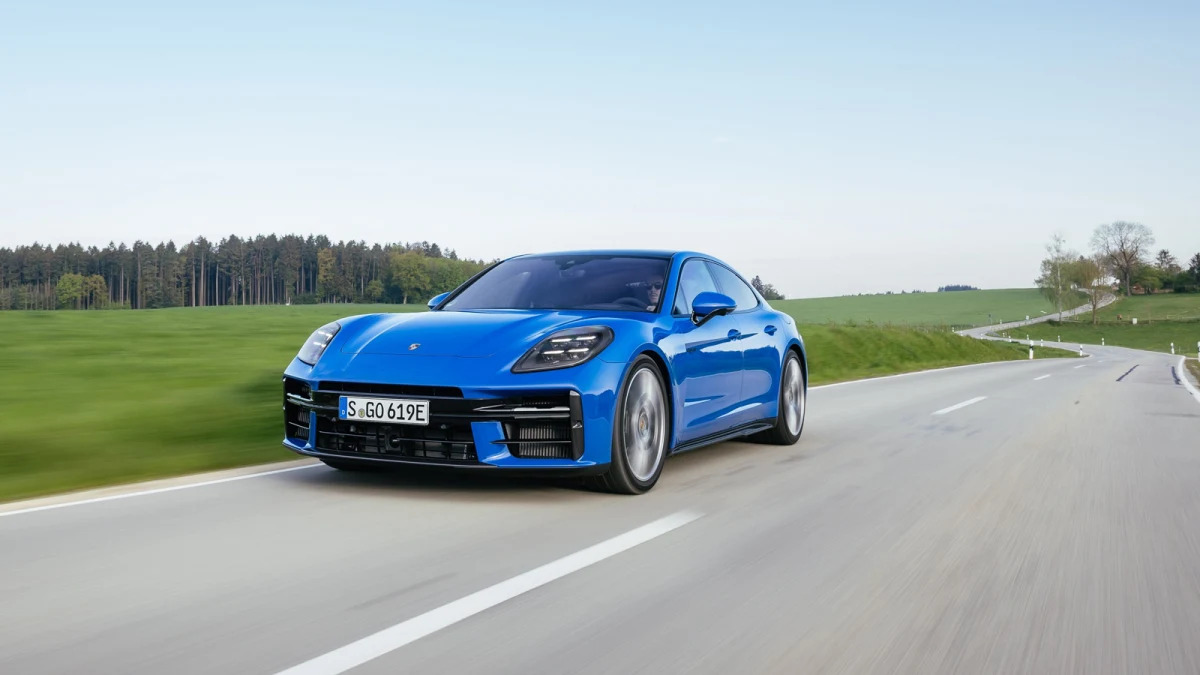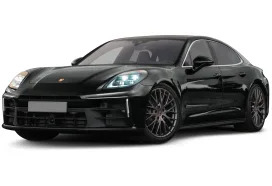STUTTGART, Germany – Cars with different drive modes are commonplace. Even a humble Kia has a Sport button that tightens up the steering a smidge and makes the throttle more responsive. Two cars in one they do not make, however. The 2024 Porsche Panamera E-Hybrid, on the other hand, comes awfully close to pulling off the trick. Not by futzing with the steering effort – that remains resolutely constant, per Porsche’s wise tradition – but by boasting the powertrains of an EV and gas-powered engine. Of course, plug-in hybrids are commonplace themselves, but this one distinguishes itself with a gasoline engine that’s characterful, accompanied by a saucy exhaust note and coupled to a transmission that snaps off shifts like a Porsche, rather than stirring through ratios like a Prius Prime. It’ll be silent and sophisticated when you need it – to work, to dinner and when stuck in traffic. But with the turn of the drive mode dial, it’ll come alive with the sort of sounds and feelings that make even the most EV-angelized car enthusiast take pause for what may be lost.
It can also make you feel like you’re piloting a boat. Or possibly something on a different planet where physics behaves just a bit differently. Plant the throttle and the nose plants along with it, like you’ve ignored a sign reading “Caution: Boat Launch.” Hit the brakes, and the nose comes up like a Jet Ski cutting its motor and rising as it slows into the water ahead. It can feel like you’re submarining in a totally un-nautical way, as if your actual body is sinking in your seat and being pulled under the steering wheel. In instances of lighter braking, it can feel like the back of the car is gently being pressed down into the road, almost like a rollerblade brake. Or an airplane pitching up for landing.
Wait, what’s going on? Exactly, things just got weird. And “weird” is the perfect word for the Active Ride suspension that’s optional on the Panamera 4 E-Hybrid and more powerful Panamera 4S E-Hybrid, even if the technology is wildly fascinating. In place of passive shock absorbers, Active Ride utilizes electrically powered hydraulic motor/pumps at each two-valve damper to independently control compression and rebound or, if you prefer, to raise or lower their entire corner of the suspension.
This takes adaptability to a new level, allowing the car to maximize handling and ride comfort like never before – it also eliminates the need for anti-roll bars since each damper reduces or eliminates roll independently. There are air springs (the standard setup is still an advanced adaptive air suspension itself), but they’re really only there to support the weight of the car when it’s off.
View this post on Instagram
For all intents and purposes, Active Ride achieves the same result as various adaptive air suspensions: It gets firmer for tauter handling, softer for a more comfortable ride and adjusts the ride height for a lower stance that benefits aerodynamics as well as handling. It just goes further than that, and all you have to do is open the door to realize it. The car pops up several inches, and yes, “pops” is the best word to describe the very quick, smooth action. After a day getting in and out of the Panamera, the trick never stopped being funny – you’re just not expecting a car to behave like that. You’re also not used to that much gap between the tire and wheel arch of a Porsche, be it a car or SUV. Even the Dakar looks like a GT3 compared to what I dubbed Panamera Wilderness mode. Sadly, you can’t drive around like that because I guess no one at Porsche appreciates that type of humor. Hopefully your passengers will appreciate the easier entry and exit into the Panamera’s deeply slung seats.
But what about all those body motions that require comparisons to various conveyances other than automobiles? The system is designed to counteract body roll and keep the car perfectly level through corners, which it most certainly does. This brand of physics-defying wizardry isn’t strictly new, however, even if the method and degree of proficiency are. It also doesn’t screw with your equilibrium as much as the pitch-mitigation functionality that’s added only when in Normal suspension mode (automatically selected in all-electric E-Power and Hybrid Auto modes; driver-selectable in Sport and Sport Plus). Maybe it’s just that while cornering, your eyes are too distracted by the typical effects of lateral inertia, but either way, there’s no missing the front suspension lowering when accelerating and raising during braking – and most noticeably resetting back to normal thereafter. It gives a whole new meaning to the automotive dynamic description of “nautical.” It’s a fascinating if potentially nauseating feeling, and maybe you’d get used to it, but honestly, why bother? It’s hard to imagine the stock air suspension not being sufficiently stellar.
Leaving Active Ride in Sport turns off the high-seas trickery, and although Germany’s chef’s-kiss pavement will always make it a little tough to determine ride quality, it seems perfectly livable. Associate Editor Byron Hurd concurred, reporting that the Active Ride-equipped non-hybrid Panamera was “quite tolerable” on Seville’s “asphalt seemingly held together by the still-whole bones of dead crusaders.” Sounds like it should be good in Michigan and California, then. Plus, with Sport selected, it makes it a lot easier to zero in on the Panamera’s improved plug-in hybrid powertrain.


The new 25.9-kilowatt-hour battery pack has 45% more capacity than before, yet doesn’t take up any more space in the body. A new 11-kW onboard charger allows for more rapid at-home charging (as little as 2.5 hours), but the car itself can recharge the battery on the fly up to 80%. How far is that all-electric range? It should be better than the previous E-Hybrid’s meager 19 miles, but official figures are not yet available. We also got into the car when it was less than fully charged, and with all the Autobahn and mountain road driving, nothing we can report would be applicable.
Both the 4 and 4S E-Hybrids feature an upgraded 2.9-liter twin-turbo V6, which produces 300 horsepower and 309 pound-feet of torque in the 4 E-Hybrid, and 348 hp and 368 lb-ft in the 4S E-Hybrid. They then share a new, more powerful electric motor (up to 187 hp and 331 lb-ft from 134/295), but due to the too-complicated-to-explain-here vagaries of PHEV’s overall power outputs, the 4S E-Hybrid is considerably more powerful than its gas engine specs would indicate. The 4 E-Hybrid is good for a total system output of 463 hp and 479 lb-ft, and hits 60 mph in 3.9 seconds; the 4S E-Hybrid is good for 536 hp, 553 lb-ft and a 3.5-second sprint. Those sprint times represent a 0.3-second pickup for the E-Hybrid and 0.4 seconds for the 4S E-Hybrid.
Although a firm, right-pedal thwack will summon the V6 in from the bullpen to lend a hand when in the all-electric E-Power mode, it was a rarity during our drive around Porsche’s home turf near Stuttgart. With either version, there’s more than enough oomph on tap from the motor to keep the car moving with vigor on the Autobahn and a mountain road alike. And thanks to its electric motor being integrated into the PDK, there are still snappy shifts along the way to make things feel normal. Now, this isn’t the only PHEV to have a traditional automatic (Hyundais, Kias and several others have them), but this is the perfect example of why Hyundai’s not so nuts for making the all-electric Ioniq 5 N simulate shifts. It just feels right in a performance setting. When the engine does pop on, such as when the TBA miles of all-electric range is depleted and the E-Hybrid mode is automatically selected, the sound of the engine is actually surprising and honestly a bit off-putting. It’s easy to forget you’re not in a plush, pure EV luxury car.
Put the car into Sport or Sport Plus, however, and the engine fires to life with the sonic accompaniment of the Sport exhaust mode. Now lay into the throttle and you’ll forget you’re not in any other internal combustion Panamera. In Sport, the PDK snaps off shifts; in Sport Plus, it can occasionally bang between them like a muscular arm slotting it into gear. The noise isn’t the ear-splitting flat-six fury of a Spyder RS, but it’s bound to make you happy. So will the talkative steering that feels delicate in your grip, and the confident road-holding made possible by Active Ride and available rear-wheel steering (a much easier-to-recommend feature). The Panamera has never been bigger or heavier, but it also has never felt so small from behind the wheel.
From the back seat, the Panamera may occasionally feel nautical in body motions, but no one will confuse the accommodations as belonging to a yacht. It’s tight back there for a pricey luxury sedan, and with the low-slung seat and high beltline, you can feel a bit below deck. It can, however, be equipped with power-adjustable seats that offer recline and, uniquely, thigh support extensions. In the back seat! The chairs up front offer more adjustability, of course, and are particularly friendly to those longer of limb. Our test cars were also spec’d with an oh-so-cool “Pepita” houndstooth fabric that’s 100 times cooler (in style) than any draping of cow. Porsche has also figured out how to keep you cooler (in temperature) by making seat ventilation work with fabric upholstery. Although as a porous material, perhaps it always was and Porsche is the first to try it?



Other interior updates for the E-Hybrids are shared with other members of this next-generation Panamera lineup. The all-digital instruments offer several different looks, but the wheel controls that select them and the information they display are insufficient and confusing, especially as the wheel controls also operate the head-up display. The new 12.3-inch touchscreen is more universally appreciated – it looks good and it’s easy to use thanks to permanently docked menu shortcuts. The navigation system guided me flawlessly through the unfamiliar and at times confusing roadscape of a foreign land. There’s also a passenger screen available, but it really just seems like showing off rather than providing any actual benefit.
The last Panamera’s center console featured a shift lever flanked by haptic-touch buttons for performance functions, infotainment shortcuts and climate controls. They’ve mostly been liquidated in favor of a cleaner look on top and a hidden wireless phone charger below. Those performance functions are now within the touchscreen, including the suspension and exhaust setting overrides that pop up on screen and linger just long enough when you turn the wheel-mounted mode selector. The climate controls are reorganized into the same panel first seen in the revised Cayenne that works well enough, but don’t provide the same satisfaction as Porsche’s old, delightfully clicky buttons. The Panamera sadly retains the touchscreen-operated air vents that happily failed to catch on in subsequent Porsches. The shifter is now the same up-down jumbo toggle found in the Cayenne and Taycan; the vehicle starter is now a button, but remains on the left side of the wheel.
No switch is more important than that little, still delightfully clicky knob on the steering wheel that goes through the Panamera E-Hybrid’s multiple personalities. Having not driven a 2024 Panamera without Active Drive, I can’t comment on the difference it makes in Sport mode – for better or for worse – but I just can’t see paying $7,150 for its bizarre behavior in Normal mode. It makes for an intriguing and at times mind-bending drive, but beneficial? The plug-in hybrid powertrain is, however.
Now, prices start at $117,495 for the 4 E-Hybrid and $128,795 for the 4S E-Hybrid, including destination, which is surprisingly a lot more than a 2025 Taycan. Pricing for the more comparably powered Taycan 4S has yet to be announced, but there’s a decent chance it’ll be at least on par. That shouldn’t do much to change the Taycan routinely outselling the Panamera, sometimes doubling it. Still, the Panamera has more interior space and can be quickly refilled with 91 at any old gas station during a road trip. Meanwhile, its all-electric capability and increased range mean it’s just as capable of silently, luxuriously and eco-mindedly wafting along on shorter trips without spewing CO2 … at least until you turn the dial and turn Herr Doctor into Mr. Hyde. It’s really that duality that makes the Panamera E-Hybrid such a special car, even if it occasionally feels like you’re yachting on Titan.












Sign in to post
Please sign in to leave a comment.
Continue